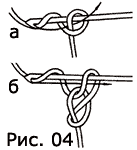
Binginging A Hook For Starters
Where?The magazine "Crunch for those who tie."
The key elements of the hook are aerial loop, a pole with no nakida and a pole with nakide. Other elements are their derivatives. The knives consist of different combinations of air hinges and poles.
The hook is held in the right hand like a pencil or a pen. The index finger is a little forward and on the hook. The end of the straw strap shall be rolled through the index finger of the left hand and pressed with the big and medium fingers (Figure 03). The straw is between the palm and the other fingers. It's called a worker. During the knitting, the hinges should be held on the hook so that they are not stretched and given the same length.
The hat from the air hinge.

For the formation of the 1st rope, the hook turns the beard to the left and puts it under its thread. The hook with the thread is rotting around the thread against the clockwise, and there's a loop on the hook. That loop sticks with a big and medium finger in a place where it's twisted. The hook turns the beard to the left, grabs the thread and extends to the hinge on the hook (Figure 04a). The thumb is taken away and the end of the threads the knot.
For the formation of the 2nd Air Petleyrice. 04b() The hook shall be placed under the thread and, by taking it, dragged through the hinge on the hook.
Many air hinges form a chain of air hinge, which serves as a starting point for almost all products (figure 05).
During the bond, a chain of hinge will be formed on the upper edge, under which the hook is inserted. At the same time, each hinge distinguishes the outer half-heart, the half of the loop on the outside, and the inner half-heart, the half of the loop on the inner side. The shape of the bundle depends on what half-heart (or under the whole hinge) is.
And another concept.
Naquid is a roll of threads on the hook after it already has a loop. Each post-distance naquid form a loop. You can use a few nakids to get poles of different heights. One nakid extends the pole to one loop, two to two loops, etc.
Half-band or connector.
It is bound at the end of the row, tied around the circle or if the beginning of the row is required. The hook shall be inserted into the hinge of the chain or the hinge of the previous row, take over the thread and extend it simultaneously through the hinge of the previous row and the hinge on the hook (Figure 06).









